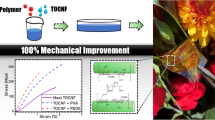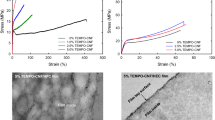Abstract
Reinforcing of cellulose nanofibril (CNF) films by partial dissolution with N-methylmorpholine-N-oxide (NMMO) was investigated. The method investigated is composed of impregnation of CNF film with liquid solution of NMMO followed by dry heat activation. The heat activation of the impregnated film was carried out using a heated calendering nip, which enabled simultaneous heating and compression. The partial dissolution of cellulose by NMMO caused a significant increase in the transparency of CNF film due to the decrease of film porosity and increased surface smoothness. The dry strength of the reinforced film was increased from 122 up to 195 MPa. Furthermore, the wet strength of the reinforced film was up to 70% greater than the dry strength of pure CNF film. The changes in the fibrillar structure were investigated with topographical imaging (SEM and AFM) and spectroscopically using NMR and FTIR. No significant changes in the fibril structure or cellulose morphology were observed. Moreover, the treated film resisted significant water pressure, highlighting CNF film’s permanent water resistance. The partial dissolution process with NMMO was also capable of reinforcing a CNF composite film with macro scale structural elements (lyocell short-cut fibres). The strategy investigated is a robust and fast method to improve the mechanical properties of fibrillary cellulose films, allowing them utilization in applications where improved water resistance and fully cellulosic character are required properties.









Similar content being viewed by others
Abbreviations
- CNF:
-
Cellulose nanofibrils
- NMMO:
-
N-methylmorpholine-N-oxidide
References
Abdul Khalil HPS, Bhat AH, Ireana Yusra AF (2012) Green composites from sustainable cellulose nanofibrils: a review. Carbohydr Polym 87:963–979. doi:10.1016/j.carbpol.2011.08.078
Ahola S, Salmi J, Johansson L-S et al (2008) Model films from native cellulose nanofibrils. Preparation, swelling, and surface interactions. Biomacromolecules 9:1273–1282
Bledzki AK, Gassan J (1999) Composites reinforced with cellulose based fibres. Prog Polym Sci 24:221–274. doi:10.1016/S0079-6700(98)00018-5
Briassoulis D (2004) An overview on the mechanical behaviour of biodegradable agricultural films. J Polym Environ 12:65–81. doi:10.1023/B:JOOE.0000010052.86786.ef
Chanzy H, Nawrot S, Peguy A et al (1982) Phase behavior of the quasiternary system N-methylmorpholine-N-oxide, water, and cellulose. J Polym Sci Polym Phys Ed 20:1909–1924. doi:10.1002/pol.1982.180201014
Duchesne I, Hult E, Molin U et al (2001) The influence of hemicellulose on fibril aggregation of kraft pulp fibres as revealed by FE-SEM and CP/MAS 13C-NMR. Cellulose 8:103–111
Fink H-P, Weigel P, Purz H, Ganster J (2001) Structure formation of regenerated cellulose materials from NMMO-solutions. Progr Polym Sci 26:1473–1524. doi:10.1016/S0079-6700(01)00025-9
Graenacher C (1934) Cellulose solutions. Patent US1943176
Hakalahti M, Mautner A, Johansson L-S et al (2016) Direct interfacial modification of nanocellulose films for thermoresponsive membrane templates. ACS Appl Mater Interfaces 8:2923–2927. doi:10.1021/acsami.5b12300
Henriksson M, Berglund LA (2007) Structure and properties of cellulose nanocomposite films containing melamine formaldehyde. J Appl Polym Sci 106:2817–2824. doi:10.1002/app.26946
Henriksson M, Berglund LA, Isaksson P et al (2008) Cellulose nanopaper structures of high toughness. Biomacromolecules 9:1579–1585
Hubbe MA, Rojas OJ (2008) Colloidal stability and aggregation of lignocellulosic materials in aqueous suspension. BioResources 3:1419
Huber T, Müssig J, Curnow O et al (2011) A critical review of all-cellulose composites. J Mater Sci 47:1171–1186. doi:10.1007/s10853-011-5774-3
Iwamoto S, Isogai A, Iwata T (2011) Structure and mechanical properties of wet-spun fibers made from natural cellulose nanofibers. Biomacromolecules 12:831–836. doi:10.1021/bm101510r
Johnson DL (1969) Strengthening swellable fibrous material with an amine oxide. U.S. 3 pp
Kapanen A, Schettini E, Vox G, Itävaara M (2008) Performance and environmental impact of biodegradable films in agriculture: a field study on protected cultivation. J Polym Environ 16:109–122. doi:10.1007/s10924-008-0091-x
Klemm D (1998) Comprehensive cellulose chemistry. Fundamentals and analytical methods, vol 1. Wiley, Weinheim
Klemm D, Heublein B, Fink H-P, Bohn A (2005) Cellulose: fascinating biopolymer and sustainable raw material. Angew Chem Int Ed Engl 44:3358–3393. doi:10.1002/anie.200460587
Klemm D, Kramer F, Moritz S et al (2011) Nanocelluloses: a new family of nature-based materials. Angew Chemie Int Ed 50:5438–5466
Ku H, Wang H, Pattarachaiyakoop N, Trada M (2011) A review on the tensile properties of natural fiber reinforced polymer composites. Compos Part B Eng 42:856–873. doi:10.1016/j.compositesb.2011.01.010
Kurihara T, Isogai A (2014) Properties of poly(acrylamide)/TEMPO-oxidized cellulose nanofibril composite films. Cellulose 21:291–299. doi:10.1007/s10570-013-0124-z
Larsson PT, Hult E-L, Wickholm K et al (1999) CP/MAS 13C-NMR spectroscopy applied to structure and interaction studies on cellulose I. Solid State Nucl Magn Reson 15:31–40. doi:10.1016/S0926-2040(99)00044-2
Lavoine N, Desloges I, Dufresne A, Bras J (2012) Microfibrillated cellulose—its barrier properties and applications in cellulosic materials: a review. Carbohydr Polym 90:735–764. doi:10.1016/j.carbpol.2012.05.026
Lucenius J, Parikka K, Österberg M (2014) Nanocomposite films based on cellulose nanofibrils and water-soluble polysaccharides. React Funct Polym 85:167–174. doi:10.1016/j.reactfunctpolym.2014.08.001
Mantanis GI, Young RA, Rowell RM (1995) Swelling of compressed cellulose fiber webs in organic liquids. Cellulose 2:1–22. doi:10.1007/BF00812768
Moon R, Martini A, Nairn J et al (2011) Cellulose nanomaterials review: structure, properties and nanocomposites. Chem Soc Rev 40:3941–3994
Nishino T, Arimoto N (2007) All-cellulose composite prepared by selective dissolving of fiber surface. Biomacromolecules 8:2712–2716. doi:10.1021/bm0703416
Oh SY, Il Yoo D, Shin Y, Seo G (2005) FTIR analysis of cellulose treated with sodium hydroxide and carbon dioxide. Carbohydr Res 340:417–428. doi:10.1016/j.carres.2004.11.027
Österberg M, Vartiainen J, Lucenius J et al (2013) A fast method to produce strong NFC films as a platform for barrier and functional materials. ACS Appl Mater Interfac 5:4640–4647. doi:10.1021/am401046x
Paakko M, Vapaavuori J, Silvennoinen R et al (2008) Long and entangled native cellulose I nanofibers allow flexible aerogels and hierarchically porous templates for functionalities. Soft Matter 4:2492–2499. doi:10.1039/B810371B
Peresin MS, Vartiainen J, Kunnari V, et al (2012) Large-scale nanofibrillated cellulose film: an overview on its production, properties, and potential applications. In: Book of abstracts international conference of pulping, papermaking and biotechnology
Qing Y, Sabo R, Cai Z, Wu Y (2013) Resin impregnation of cellulose nanofibril films facilitated by water swelling. Cellulose 20:303–313. doi:10.1007/s10570-012-9815-0
Rosenau T, Potthast A, Sixta H, Kosma P (2001) The chemistry of side reactions and byproduct formation in the system NMMO/cellulose (lyocell process). Progr Polym Sci 26:1763–1837
Schasfoort RBM, Tudos AJ, Gedig ET (2008) Handbook of surface plasmon resonance. The Royal Society of Chemistry, Cambridge
Spoljaric S, Salminen A, Luong N, Seppälä J (2013) Crosslinked nanofibrillated cellulose: poly(acrylic acid) nanocomposite films; enhanced mechanical performance in aqueous environments. Cellulose 20:2991–3005. doi:10.1007/s10570-013-0061-x
Syverud K, Stenius P (2009) Strength and barrier properties of MFC films. Cellulose 16:75–85
Tammelin T, Hippi U, Salminen A (2013) Method for the preparation of nanofibrillated cellulose (NFC) films on supports. PCT Int Appl 13 pp, Chemical Indexing Equivalent to 160:342652
Toivonen MS, Kurki-Suonio S, Schacher FH et al (2015) Water-resistant, transparent hybrid nanopaper by physical cross-linking with chitosan. Biomacromolecules 16:1062–1071. doi:10.1021/acs.biomac.5b00145
Vanderhart DL, Atalla RH (1984) Studies of microstructure in native celluloses using solid-state carbon-13 NMR. Macromolecules 17(8):1465–1472
Virtanen T, Maunu SL (2014) NMR spectroscopic studies on dissolution of softwood pulp with enhanced reactivity. Cellulose 21:153–165. doi:10.1007/s10570-013-0144-8
Visanko M, Liimatainen H, Sirviö JA et al (2014) Porous thin film barrier layers from 2,3-dicarboxylic acid cellulose nanofibrils for membrane structures. Carbohydr Polym 102:584–589. doi:10.1016/j.carbpol.2013.12.006
Walther A, Timonen JVI, Díez I et al (2011) Multifunctional high-performance biofibers based on wet-extrusion of renewable native cellulose nanofibrils. Adv Mater 23:2924–2928. doi:10.1002/adma.201100580
Wachsmann U, Diamantoglou M (1997) Potential des NMMO-Verfahrens für Fasern und Membranen. Das Pap 51:660–665
Acknowledgments
The work was carried out in the Design Driven Value Chains in the World of Cellulose project (DWOC) funded by Tekes the Finnish Funding Agency for Innovation. The authors also thank the Academy of Finland. The authors appreciate the help given by Unto Tapper (SEM imaging), Tommi Virtanen (NMR analysis), Vuokko Liukkonen (helping with calendering), Hanna Kyllönen (filtration testing), and Salonen Ulla (helping with the tensile testing).
Author contributions
The manuscript was written through contributions of all the authors. All authors have given approval to the final version of the manuscript.
Author information
Authors and Affiliations
Corresponding author
Electronic supplementary material
Below is the link to the electronic supplementary material.
Rights and permissions
About this article
Cite this article
Orelma, H., Korpela, A., Kunnari, V. et al. Improving the mechanical properties of CNF films by NMMO partial dissolution with hot calender activation. Cellulose 24, 1691–1704 (2017). https://doi.org/10.1007/s10570-017-1229-6
Received:
Accepted:
Published:
Issue Date:
DOI: https://doi.org/10.1007/s10570-017-1229-6




